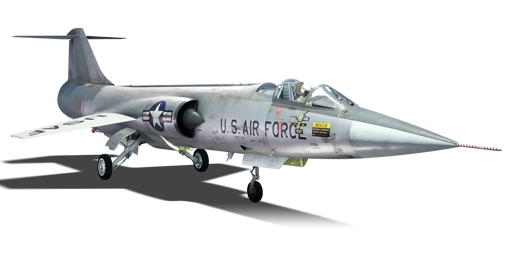



The first production version of the Starfighter series was the F-104A. 140+ F-104A Starfighters were ordered by the USAF and in total 170 Starfighters were in service (some YF-104As were converted to production standard). The F-104A had a stronger airframe as well as additions made to the airframe for stability. The F-104A was planned to replace the ageing F-100 Super Sabre but later didn't fit the requirements set by the USAF. It was stuck in limbo until problems with the production of the Convair-built F-106 let the Starfighter live on in another role, interdiction. At this time, the F-104A was powered by the J79-GE-3A which was riddled with issues. The F-104As were grounded shortly after to resolve the issues with the -3A until the J79-GE-3B came to fruition. Even after the engine change, the USAF still found the F-104A to be lacklustre for air interception due to the lack of all-weather capability and low endurance. Many surplus Starfighters were sent to other countries.
Introduced in Update "Starfighters", the F-104A is quite a capable aircraft thanks to its J79 engine, cannon, and missiles. The F-104A regularly faces subsonic aircraft like the F-86 and Yak-38 so players should stick to using its immense speed and boom and zooming targets. The F-104A struggles with manoeuvrability so dogfights are highly discouraged, especially against subsonic aircraft. Furthermore, the F-104A can easily outrun many of its opponents so there is no point in staying slow to try and acquire a kill. In addition to the cannon, the F-104A also comes equipped with two AIM-9B Sidewinders which are mainly helpful in forcing an opponent to turn or against slow targets. The AIM-9B is a very situational missile and depends on a lot of factors. Overall, the F-104A is one of the most feared aircraft at its battle rating.
flaps
flaps
flaps
brake
| Belt | Belt filling | Armor penetration (mm) at a distance: | |||||
|---|---|---|---|---|---|---|---|
| 10 m | 100 m | 500 m | 1000 m | 1500 m | 2000 m | ||
| HEF-I/API-T/AP-I | 40 | 36 | 22 | 12 | 6 | 3 | |
| HEF-I/HEF-I/API-T/HEF-I/HEF-I/AP-I | 40 | 36 | 22 | 12 | 6 | 3 | |
| API-T/AP-I/AP-I/AP-I/HEF-I | 40 | 36 | 22 | 12 | 6 | 3 | |
| HEF-I/AP-I/AP-I | 40 | 36 | 22 | 12 | 6 | 3 | |












Flight performance | |
|---|---|
Survivability |
|---|
Weaponry | |
|---|---|